A video on the making, inspiration and production of the Noel Carrington and Edward Bawden’s book, Life In An English Village.
Edward Bawden – Life In An English Village Discovered
A video on the making, inspiration and production of the Noel Carrington and Edward Bawden’s book, Life In An English Village.
Edward Bawden – Life In An English Village Discovered
In 1957, Chris Prater and his wife Rose, with a working capital of pounds 30, went into business as commercial screenprinters. Rose’s maiden name was Kelly, so they combined it with Prater, and called the workshop Kelpra Studio. Inside a decade, the brilliantly inventive images that Prater printed for many of Britain’s most famous artists had won his workshop an international reputation.
Prater grew up in Battersea wanting to be an artist, and could not remember a time when he did not draw or paint. As his father was a cripple however, he went out to work as soon as he was 15, and it was as teaboy to a signwriter that he first saw screenprints being made.
During the Second World War, he served in the infantry, then as a troop- carrying glider pilot, until his legs were injured in a crash. After the war, he won a scholarship to art school, but when his first wife complained that she would not be able to manage on the grant, he took a job as a telephone engineer. But he also studied drawing and etching five nights a week at the Working Men’s College. †
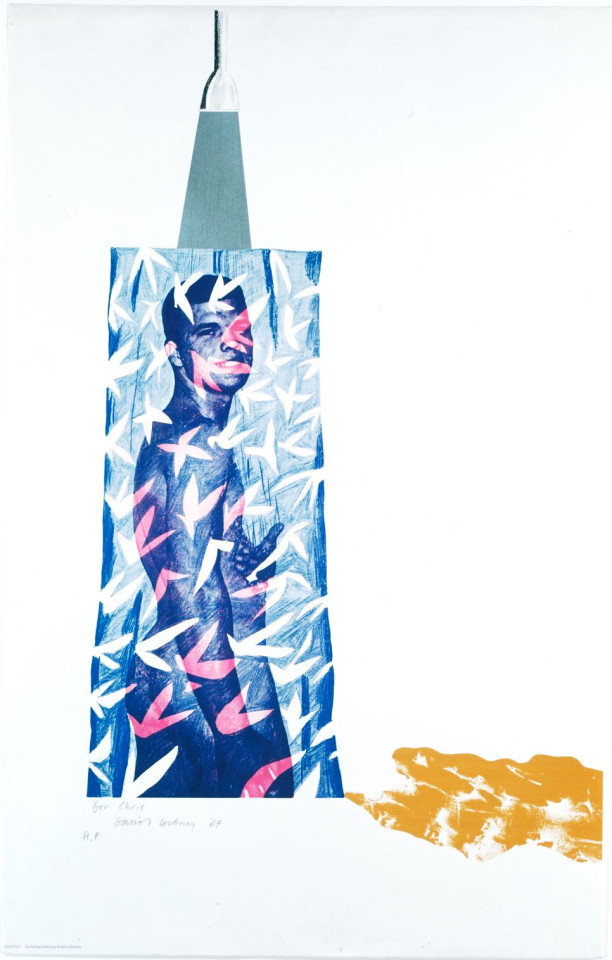
David Hockney – Cleanliness is Next to Godliness, 1964
In 1951 he went on a three-month government training scheme and became a screen printer and worked for many printers in London.
The Kelpra Studio was set up originally in Kentish Town as a screen printing company working off an old kitchen table. Many of the early prints they made were for theatres and arts organisations. In 1959 they made their first artist print for Gordon House.
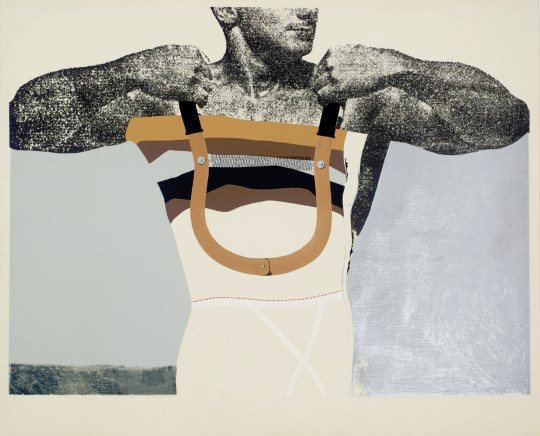
Richard Hamilton – Adonis in Y fronts, 1963
Kelpra Studio had printed Adonis in Y-fronts for Hamilton and from that time their studio defined the 60s print scene in London, in 1964 they printed: Gillian Ayres, Peter Blake, Patrick Caulfield, Bernard Cohen, Robyn Denny, David Hockney, Howard Hodgkin, Allen Jones, R.B. Kitaj, Victor Pasmore, Peter Phillips, Bridget Riley and William Turnbull.
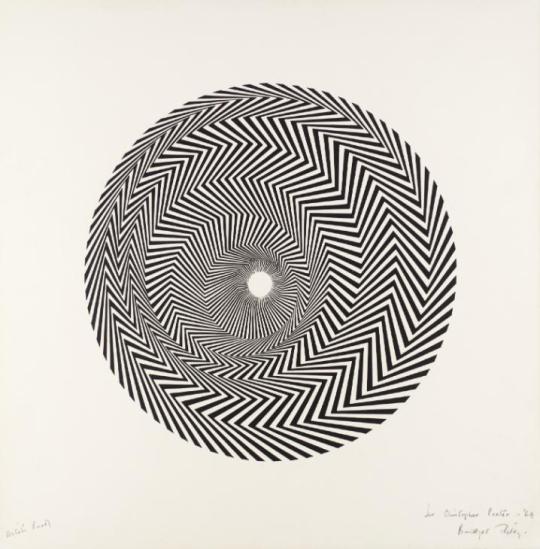
Bridget Riley – Blaze, 1964
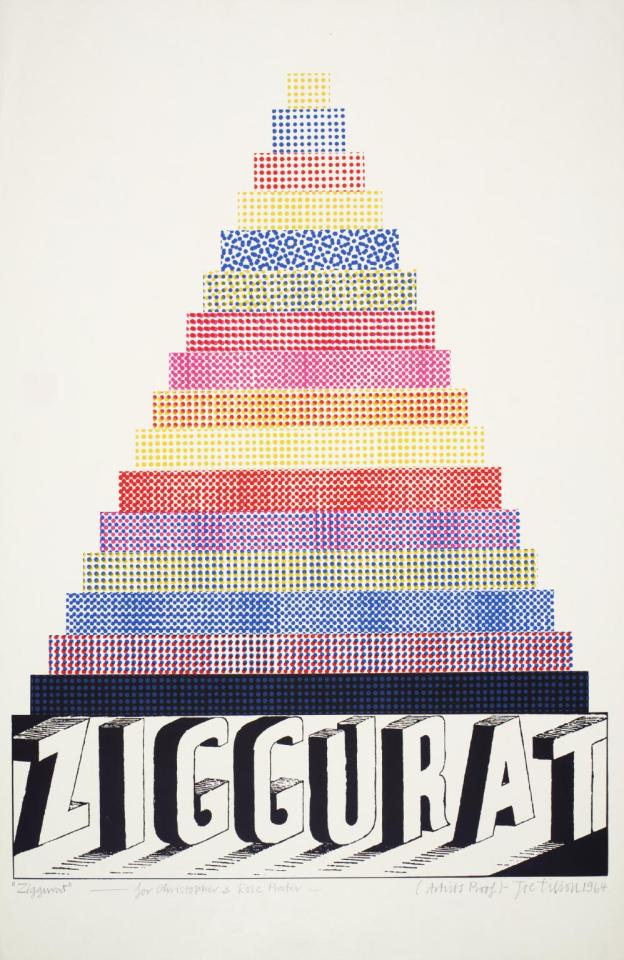
Joe Tilson – Ziggurat, 1964
† Pat Gilmour – Obituary: Chris Prater, Friday 8 November 1996 01:02
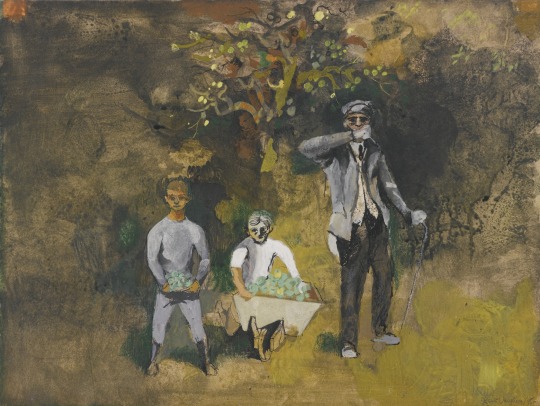
Keith Vaughan – An Orchard by the Railway, 1945
Here is an account from Keith Vaughan’s diary of his Victory in Europe Day. As many in the cities danced and cheered in the streets Vaughan was on the fringes and knew of the news too late. From Keith Vaughan – Journals, 1939-1977:
They had no wireless in the cottage where I had supper, so I didn’t hear the nine o’clock news. Walking back to the camp afterwards, the first sign of anything unusual I noticed was a string of small triangular flags being hoisted up across the road by some workmen. The flags appeared quite suddenly out of the leaf-laden boughs of the chestnut, crossed a patch of sago-coloured sky, and disappeared in the dark foliage of another tree. They looked surprised to be there. They were not new flags. They had flapped for a jubilee and a coronation and numerous local festivals, and now they seemed to be getting a little tired of it all. They were faded and grubby and washed-out looking. They hung languidly in the bluish evening air. The workmen tapped away at the trees and thrust ladders up into the ripe foliage, bringing down showers of leaves and a snow of pink and white blossom. Further on there was a cottage with two new Union Jacks thrust out from the windowsill. They hung down stiffly to attention. Against the mellow sunbleached texture of the stone their strident colours looked ridiculous and, because they were there on purpose to disturb the familiar contours, they gave a feeling of uneasiness. From there onwards all the little cottages were sprouting flags.
There was no one about to see them, and no very clear reason how they came to be there. Menacing each other across the road with their shrill colours they were like a flock of rare and fabulous birds which had alighted suddenly and without warning, clinging to chimney pots, windowsills and door posts. They were of many different sizes and shapes and attitudes corresponding partly to the income levels and patriotic fervor of their owners and partly to a certain capriciousness which they seemed to acquire on their own. Some of them, having been unfurled, had hitched themselves up again shyly over the poles. Others had a narrow strip of wood fastened along the extreme edge, so they were forced to suffer the maximum exposure. The large houses had older flags sewn together with pieces of silk with white painted poles and sometimes a gold tassle. The cottages all had new flags; the pieces of calico dyed with raw-looking colours. And when it rained they would run.
Outside one cottage an old woman was standing in a black dress with folded arms. She stood there most evenings, and I had passed her a hundred times without either of us taking any special notice of the other. But to-night she seemed to be standing there for a special purpose, as though expecting something to happen. As I passed her she smiled broadly at me. It was an indescribable smile that lay right across the road blocking my way and demanding an answer. I acknowledged it and hurried past, feeling guilty and uncomfortable and afraid that I might suddenly be called to play some part I had not rehearsed.
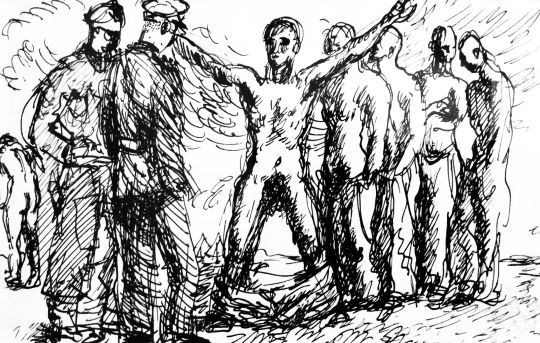
Keith Vaughan – Army Medical Inspection, 1942
On the dung-crusted door of a stable a V had been made with red, white and blue ribbon, and inside the V, hurriedly chalked as an afterthought, a red E. In the little window of the grocer’s was a newspaper cutting of the Prime Minister. It was stuck on the window with four large pieces of brown tape like a police notice. In the window that has bird seed and bottles of sauce was a gold frame with a reproduced oil-painting of two exceedingly mild and dignified lions, and in the bottom left hand corner the words ‘PEARS.’ In front there was a photograph of the Royal Family in sepia, with the word ‘CORONATION’ underneath and round circle of rust from a drawing pin. All the familiar and reliable things had suddenly disclosed a secret and unsuspected threat, though it would be impossible to say exactly what it was they threatened. But when the last house was passed and there were only fields and hedges and ditched frothing with tall white cow-parsley, there was a feeling of relief and reassurance.
Where the road swings sharply to the right before reaching the camp I crossed the little footbridge and sat down on the stile to smoke a cigarette. Between the layers of high lead-coloured cloud and the horizon, a narrow margin had been left in which the sun burned an enormous liquid orange disc. The air was like a thin violet fluid. In the further field was the boy who drives the tractor every morning past the camp. He was shooing some geese under a fence and into the straw-strewn yard if the cowhouse. He walked slowly forward towards the geese and at each step brought both arms up simultaneously above his head as though he were lifting something large that had suddenly lost all weight. His skin and clothes were soaked with the orange liquid from the sun. When the geese had gone he went out of sight behind the barn.
The near field was full of sheep. The full, woolly forms with sharp accents of light against the dark grass, the alternation between light-coloured sheep and dark ones, small and large, had that air of carefully-planned accident which one sometimes sees in paintings, but not often in nature. They glowed a deep gold colour like lumps of phosphorescent substance, and there were little pools of violet between their legs and in their ears. Two sheep had strayed down on to the steep bank of the ditch and were tearing ravenously at the thick, dark water-grass which met over their backs. They had pushed their way through gaps in the hedge and seemed to be expecting at any moment to be driven back. They were gulping as much as they could in the time, their eye wide with anxiety. Standing almost vertically faced downwards, they seemed to be in the most disadvantageous position both for eating and for coping with any sudden emergency that might arise.
The grass in the field was lighter in colour and had already been grazed down to a short turf like the thick pile on a carpet. Each sheep was eating with a sort of desperate concentration as though it had not seen grass for some time. They just kept their heads down and moved slowly forward, one foot at a time. But some, perhaps, because their necks had got stiff, had bent their front legs and were kneeling on their little fluffy knees with their black hoofs tucked up off the ground so as not to soil them and their backsides sticking absurdly into the air. The rams had hardly any wool and their skins had that grey, flatulent look that dead sheep have. They seemed inflated with eating and walked about painfully and awkwardly as though they were pregnant. They seemed just able to eat and transport their cumbersome genitals and excrete the little shiny damp balls of dung from time to time. That was a complete existence. The only sound was the crisp tearing of grass and an occasional low grunt and from the nearer sheep the muffled reverberations of some digestive process and blowing out of wind suddenly through the nostrils.
This, then, I thought, was the beginning of it all. This was perhaps the oldest thing on earth. Before cities and civilizations men had sat and watched sheep graze. In Canaan and Galilee and Salonica and Thrace, on the mountain slopes of Olympus and the Caucasus, on the plains of Hungary and the shores of the Black Sea, in Lombardy, Burgundy, Saxony, along all the routes where men had fought and followed, searching for a home and a pasture, sheep had grazed and men had watched them. Daphnis, Hyacinthus, Thyrsis, Corydon and the famous and anonymous shepherds of Galilee. And I tried to remember all that had gone on as an accompaniment to that watching, the immense architecture of hope that had been built up round sheep. The burnt offerings and symbols of love and innocence; the preyed-upon, the lost and the helplessly young. Sacrificed, worshipped, or just eaten, through mankind’s long adolescence sheep went on being sheep, somewhere in the background of every picture, greedy and silly and perpetually anxious. And each year the same disappointing story of promise and unfulfilment. The tiny wet thing with enormous legs first learning to kneel in the winter grass, as awkward and dangerous-looking as a child with a deck chair. The insolent butting at the udders. The entirely beautiful and unnecessary prancing of lambs, movement purely for the sake of movement, only to be forgotten in a few months in a complacent and woolly middle age.
Out of the north a flock of Fortresses came flying high. It was time for them to come and they crossed every night. The slowly-mounting noise focused the uneasiness in the air. Then I realized that tonight they would not be carrying bombs; the meaning of all the little flags suddenly became real. It was as if one had dreamt the noise: the approaching impersonal menace, the indiscriminate individual death and obliteration of cities, then at the climax of terror, walking, recognized the cause of the dream – after all, only airplanes flying. A sense of absolute security closed over every thing.
The sun has gone and over the horizon was left a stain of dried blood. The air was the colour of watery ink. At the camp the German bugler was blowing lights out. The sheep had finished eating and sat with folded feet, looking without concern on the first night of peace.
60 Pictures in ‘51 was part of the Festival of Britain celebrations, a touring exhibition of art with 60 paintings by Britain’s leading artists. It came with a booklet but like many books of the time, all the images were in monochrome. I thought it would be entertaining to present the pictures in colour and though I haven’t found all of the paintings, here is what I amassed.
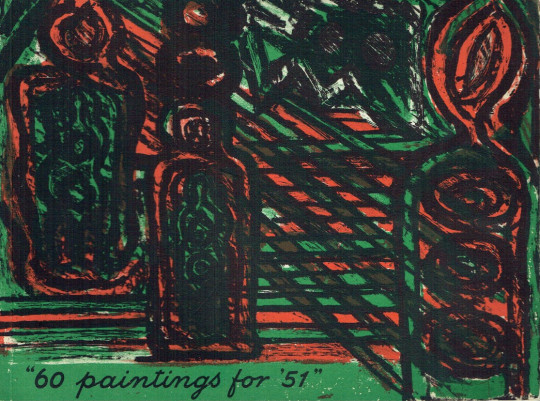
Gerald Wilde cover for the book 60 Paintings for ‘51.
If the Festival of Britain is to achieve its avowed aim of showing the British way of life in all its various facets it is clearly appropriate that a number of our distinguished painters and sculptors should have been given an opportunities to make their contribution.
With this very end in view – and also in the hope of handing down to posterity from our present age something tangible and of permanent value – the Arts Council has commissioned twelve sculptors and invited sixty artists to paint a large work, not less than 45 by 60 inches on a subject of their own choice. †
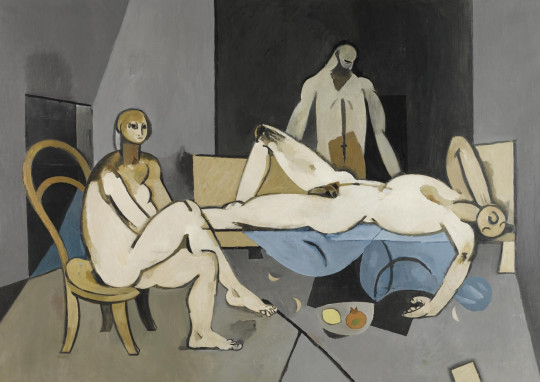
Keith Vaughan – Interior at Minos, 1950
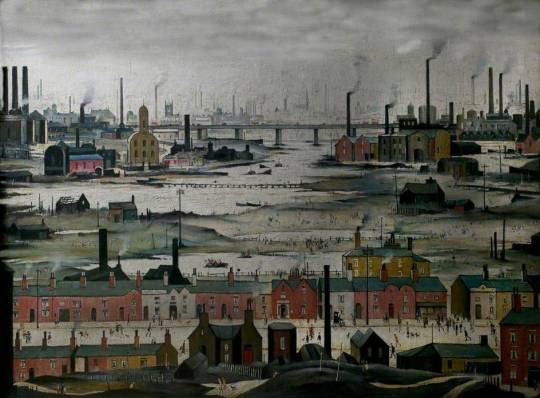
L S Lowry – Industrial Landscape, River Scene, 1950
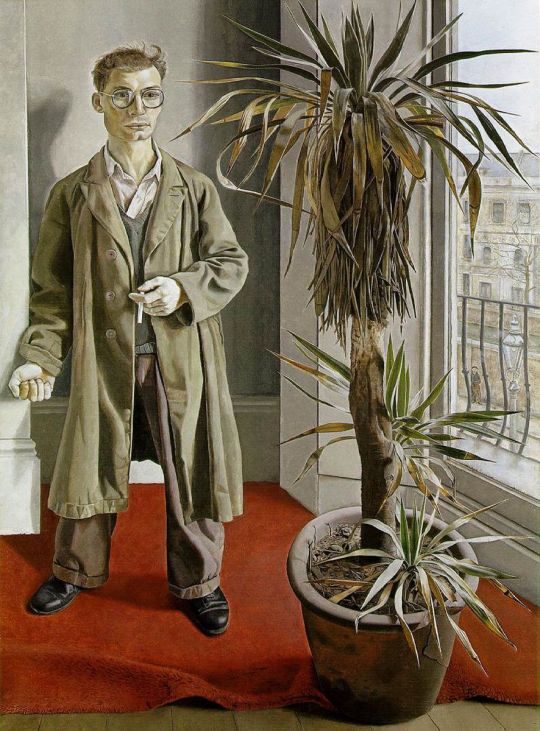
Lucian Freud – Interior Near Paddington, 1951
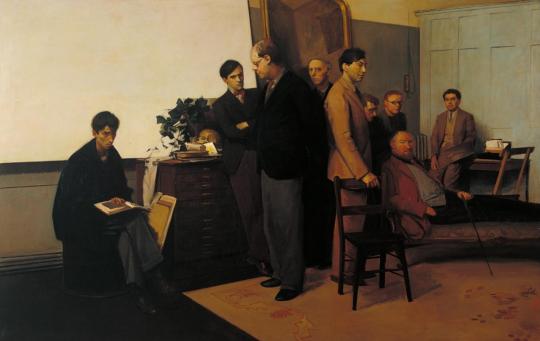
Rodrigo Moynihan – Portrait Group, 1951
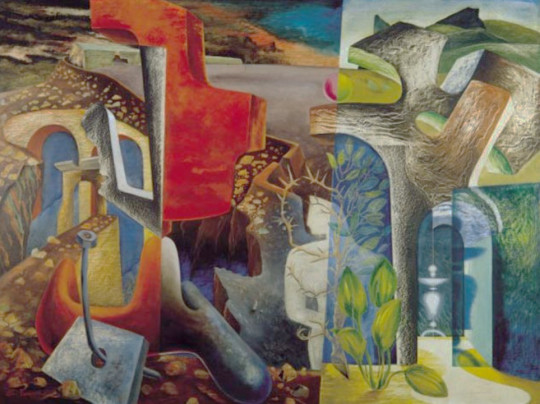
John Tunnard – Return, 1951
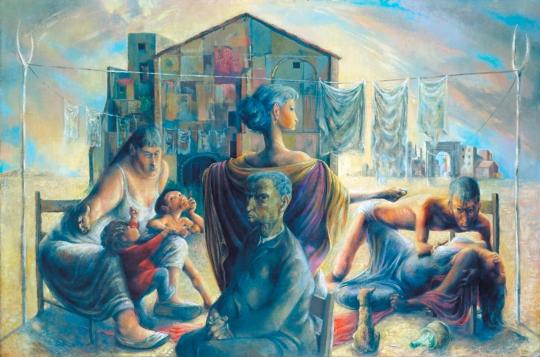
Michael Ayrton – The Captive Seven, 1950
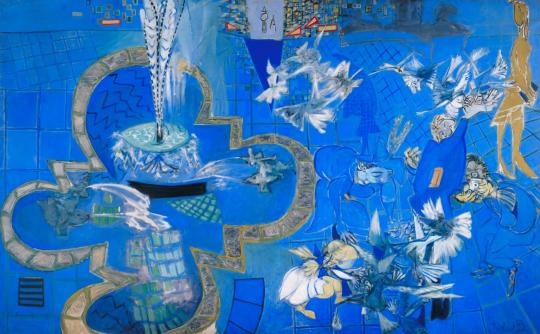
Ceri Richards – Trafalgar Square, London, 1950
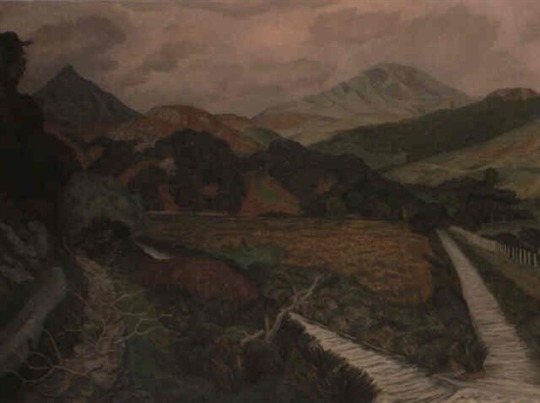
John Nash – Afon Creseor, North Wales , 1951
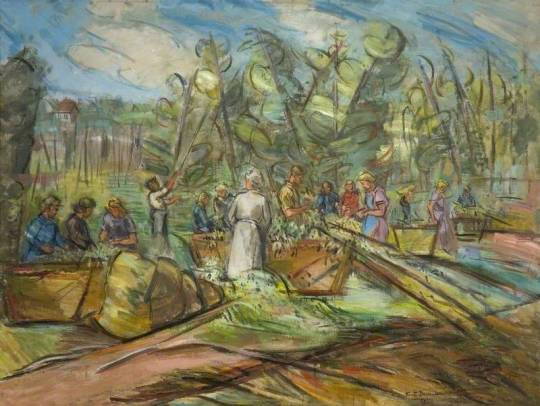
Keith Baynes – Hop-Picking, Rye, 1950
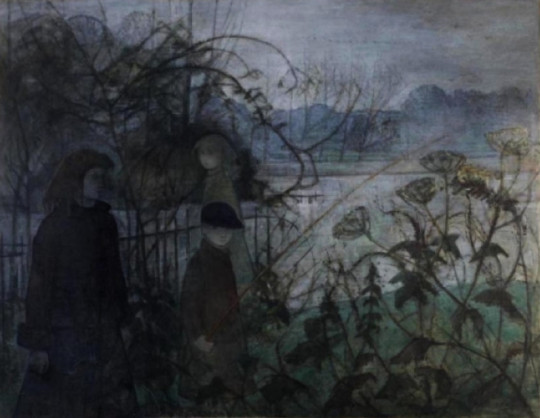
Elinor Bellingham Smith – The Island, 1951
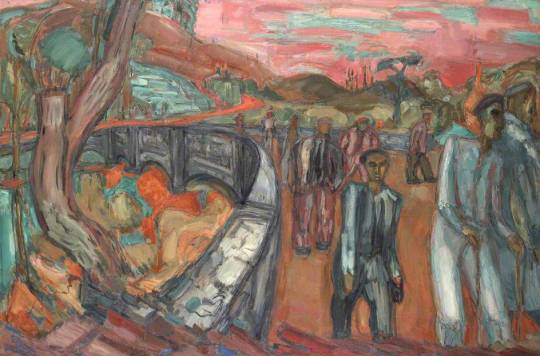
Martin Bloch – Down from Bethesda Quarry, 1951
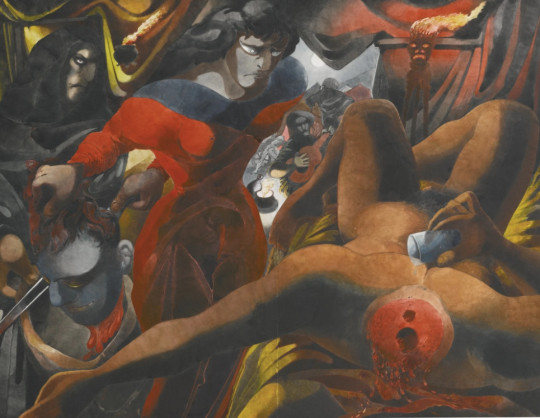
Edward Burra – Judith and the Holofernes, 1951
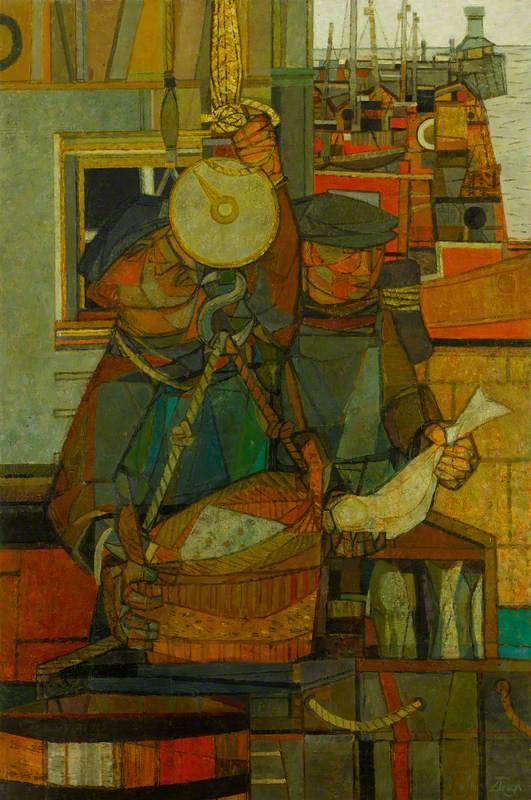
Prunella Clough – Lowestoft Harbour, 1951
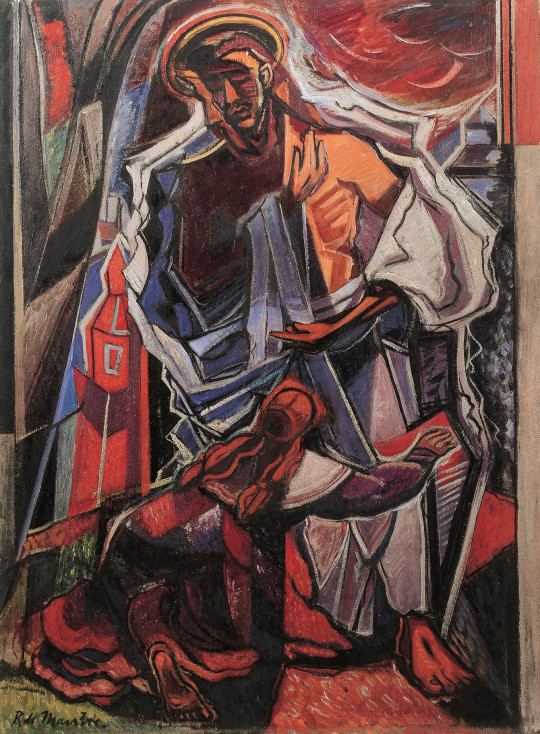
Roy de Maistre, Noli Me Tangere
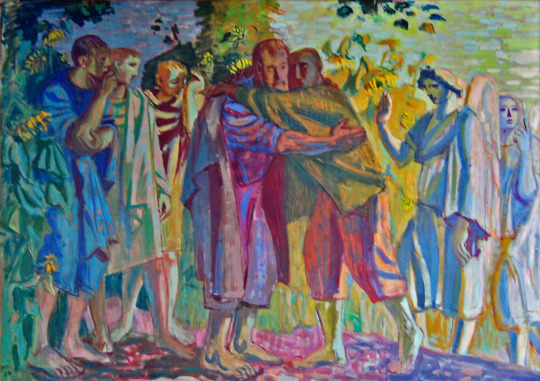
Hans Feibusch, The Prodigal Son
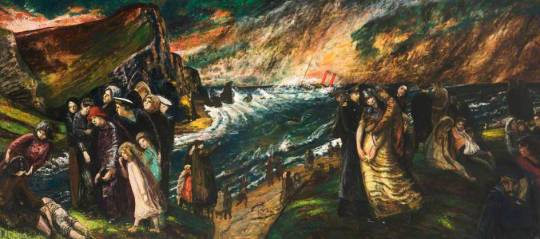
Carel Weight, “As I wend to the Shores…”
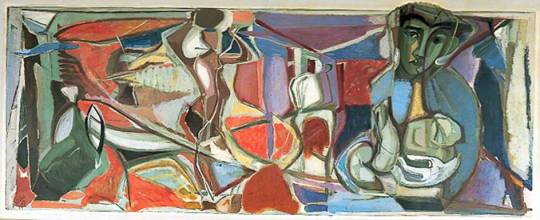
Ivon Hitchins, Aquarian Nativity, Child of this Age
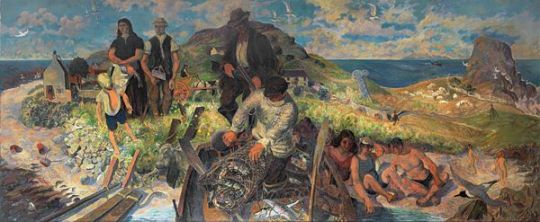
Gilbert Spencer, Hebridean Memory
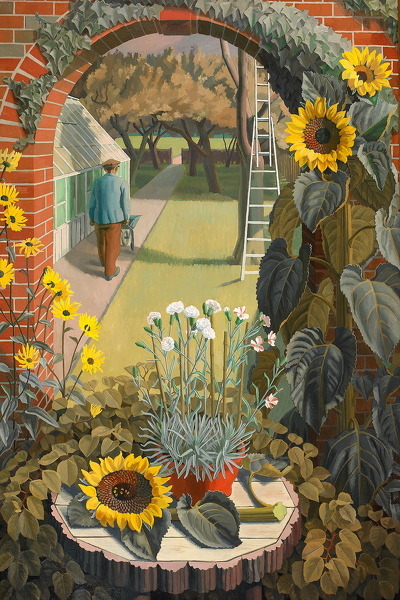
Charles Mahoney – The Garden, 1950
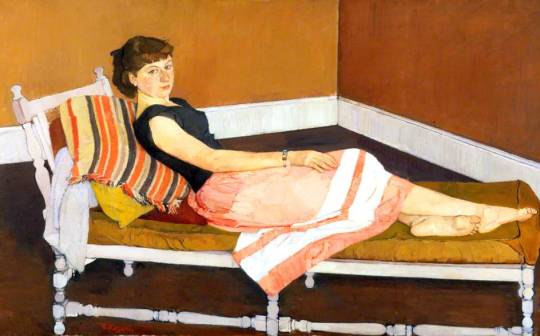
Claude Rogers, Miss Lynne
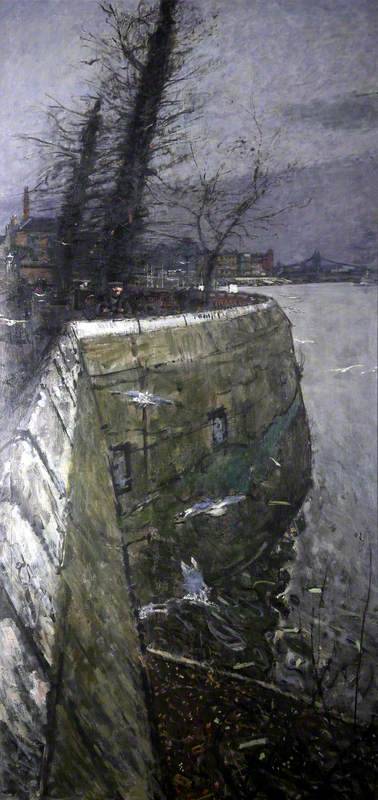
Ruskin Spear – River in Winter, 1951
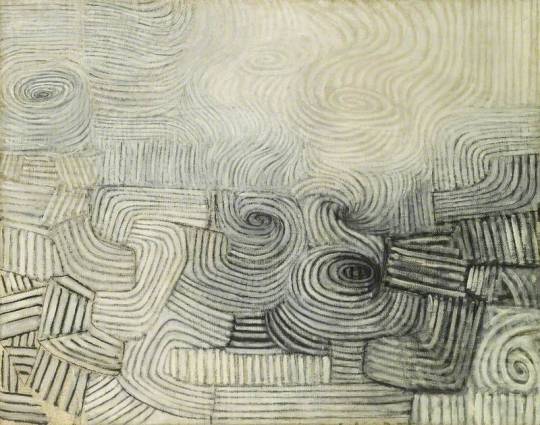
Victor Pasmore – The Snowstorm: Spiral Motif in Black and White, 1951
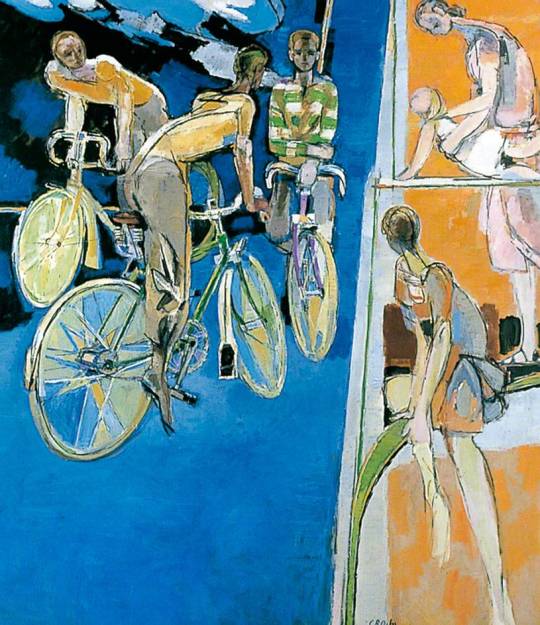
Robert Medley – Cyclists against a Blue Background, 1951
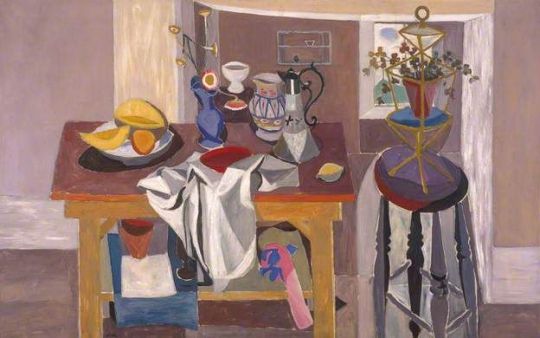
William Gillies – The Studio Table, 1951
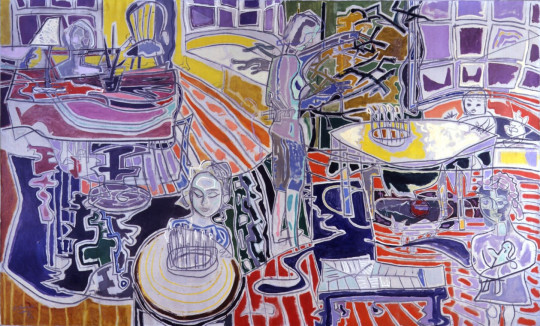
Patrick Heron – Christmas Eve, 1951
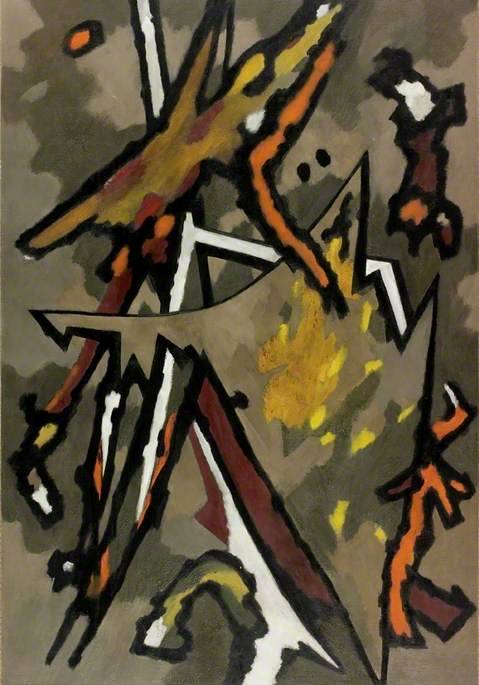
William Gear – Autumn Landscape, 1950
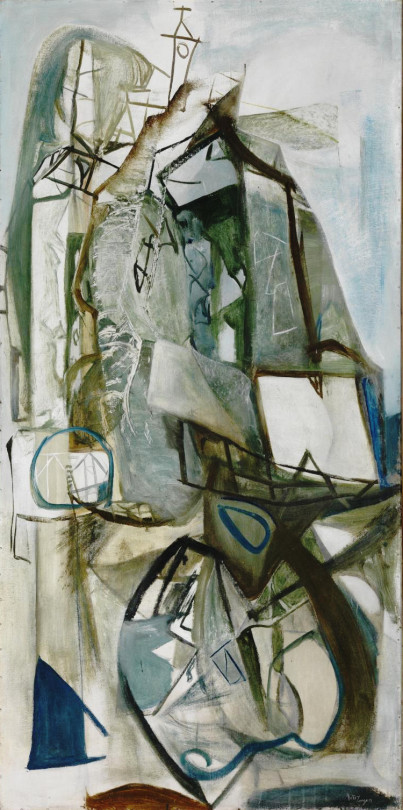
Peter Lanyon – Porthleven, 1951
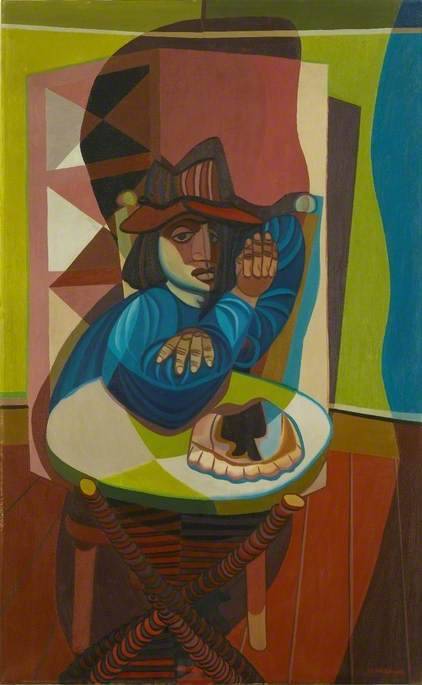
Robert MacBryde – Figure and Still Life, 1951
Below are some of the sculptures mentioned in the forward, but these really had their own booklet and part of the Battersea Park Festival Of Britain Pleasure Garden.
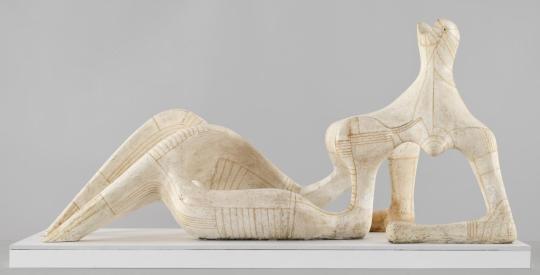
Henry Moore – Reclining Figure, 1951
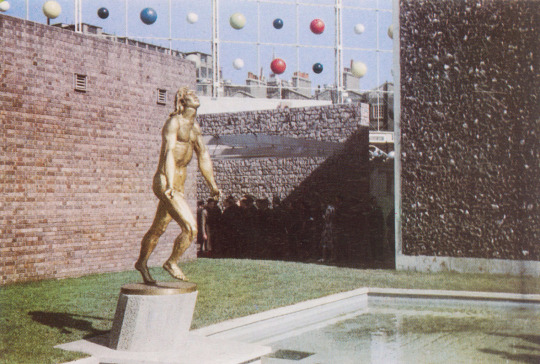
Jacob Epstein – Youth Advances, 1951
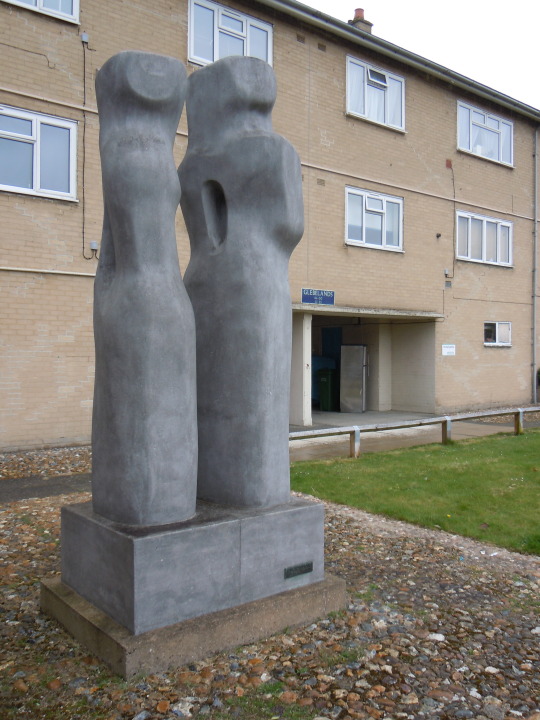
Barbara Hepworth
Contrapuntal Forms, 1951
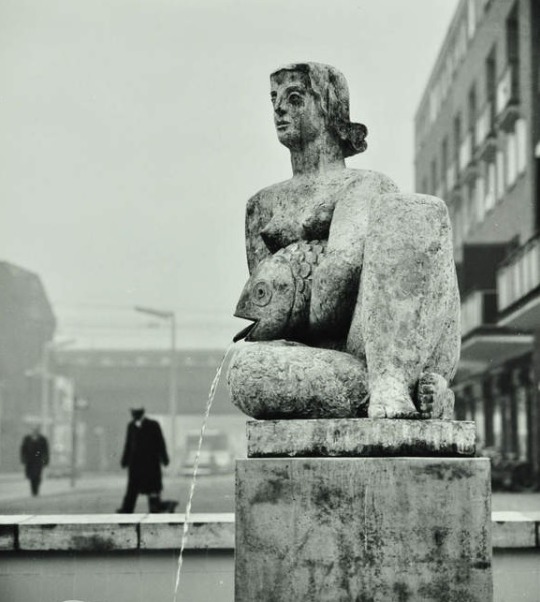
Frank Dobson – Woman and Fish, 1951
The statue above stood in Frank Dobson Square, Tower Hamlets until it was vandalised and she had her head destroyed. Now with scars she sits in Delapre Abbey, Northampton, pictured below.
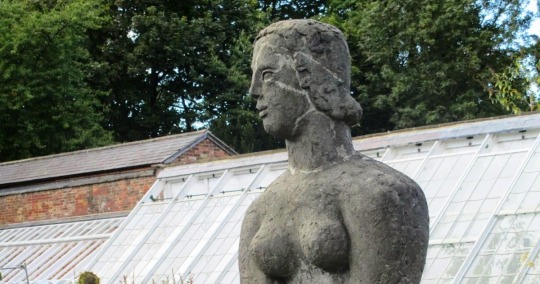
† Philip James – 60 Paintings for ‘51, 1951
This week on instagram I will be broadcasting live with Mark Hill, an informal chat from 7pm On Thursday. Join us if you can, gives you time to clap the NHS at 8pm.

In Judy Taylor’s book Sketches for friends, 2002 are a series of Edward Ardizzone’s illustrated letters. Some I have illustrated below. From reading the Tim series of books, Edward Ardizzone seemed like a kind person and his letters have a joy to them as well with all the comic illustrations.
It was an age when the postal service would run almost continuously and you could send a letter in the morning and know it would get there in the evening. You could keep in contact throughout the day.
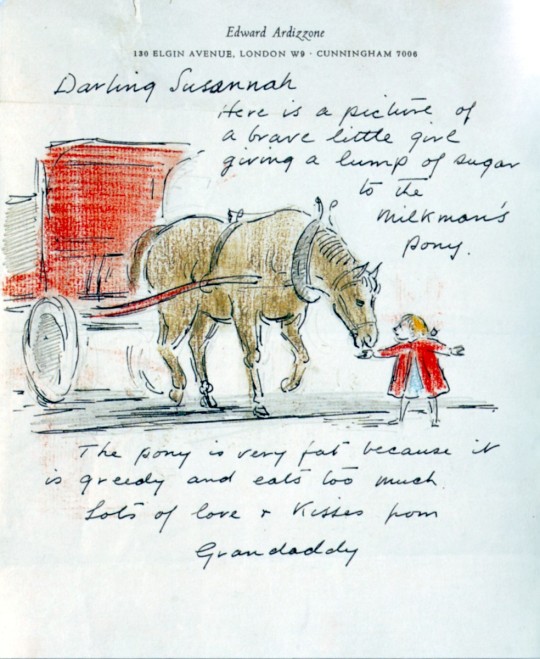
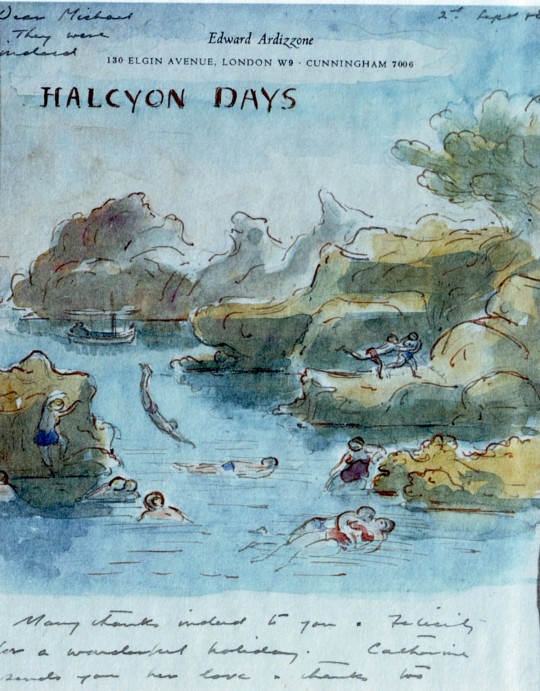
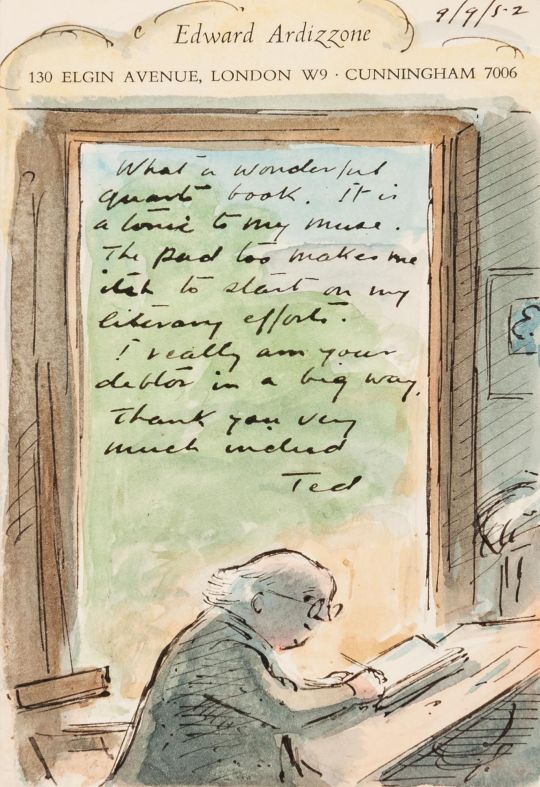
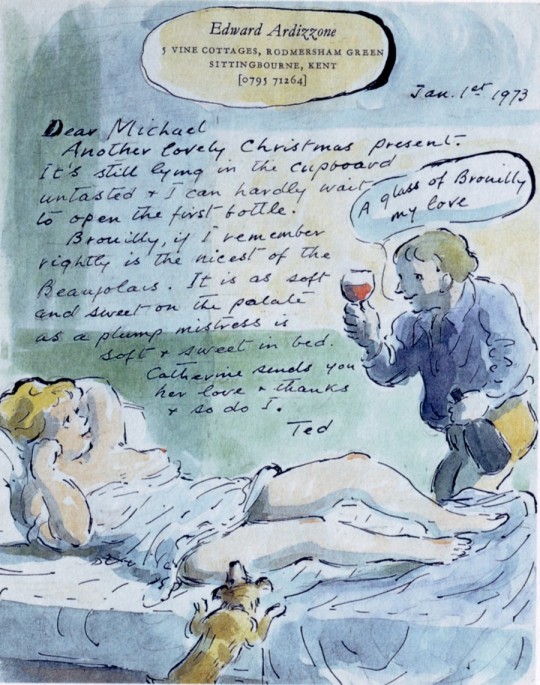
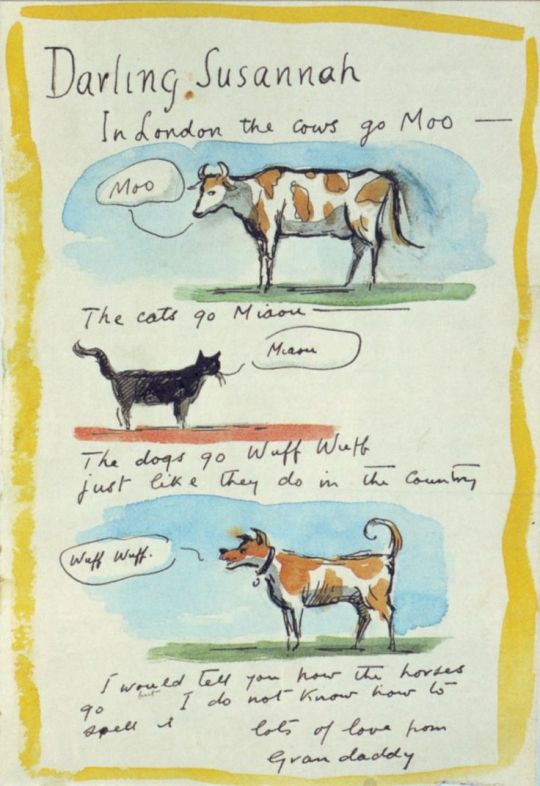
Lindsell is a village neighbouring Great Bardfield, Essex. The church is dedicated to St Mary The Virgin and dates back to Norman period with many alterations since. It was a church that Bawden would paint and print from different angles being in walking distance from his home at Brick House.
Although the styles are much the same the colour pallets are different. The linocut at the bottom of the page is very large and in life, has the texture and detail as this first watercolour.
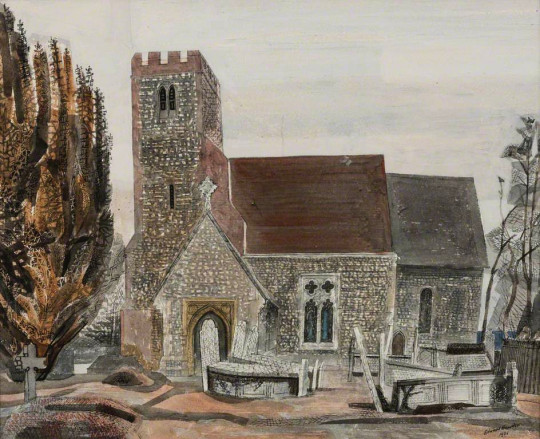
Edward Bawden – Lindsell Church, 1956
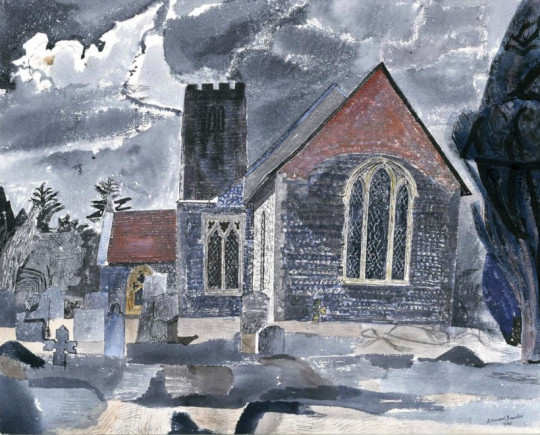
Edward Bawden – Lindsell Church, 1956
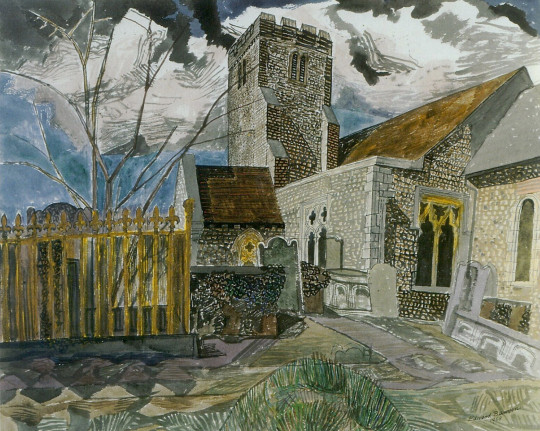
Edward Bawden – Lindsell Church, 1958
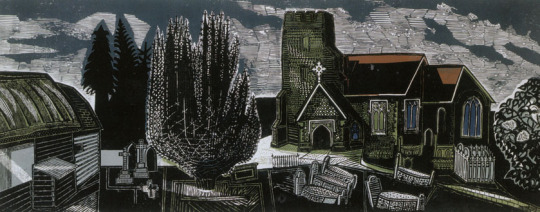
Edward Bawden – Lindsell Church, 1961
Born in Scarborough, Kenneth Rowntree’s father was the manager of the local department store who displayed his work in the shop, this may have been why Rowntree changed from training to be a cellist to becoming an artist. He studied at the Ruskin Drawing School, Oxford and went to the Slade School in London.
In 1941, Rowntree had moved to Great Bardfield, settling with his wife Diana (née Buckley) into the “a handsome draughty house” Town House. There they would be neighbours to Edward Bawden and Eric Ravilious lived in Castle Hedingham a few miles away.
The paintings Kenneth Rowntree made during war time are rather curious because they are not on the front line. Unlike many of the other official war artists, Rowntree was a Conscientious Objector. He did paint the domestic scenes of life during wartime, but not pictures of the war maneuvers.
The picture below is of a Polo Ground is a good example of his work. The pitch as been converted into growing produce and the people working for the war effort but making food.
The figure of the man signifying the every man worker to me says ‘we are all in this together’. Below are five of his paintings for the War Artist Scheme.
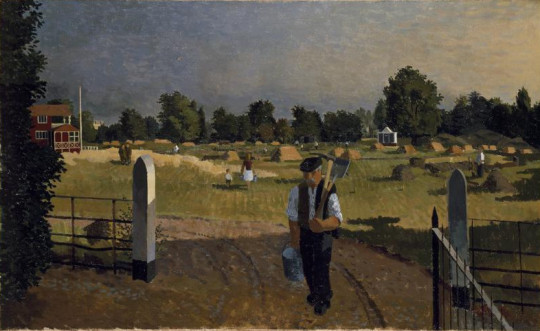
Kenneth Rowntree – A Polo Ground in War-time, 1940
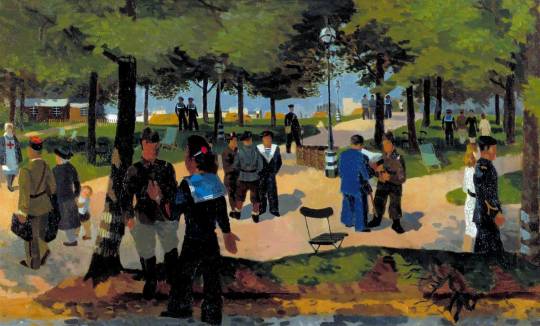
Kenneth Rowntree – Foreign Servicemen in Hyde Park: Early Summer, 1940
In the picture above, the mixture of uniforms is a good indication of how many parties are mixed up in the conflict. A subtle communication.
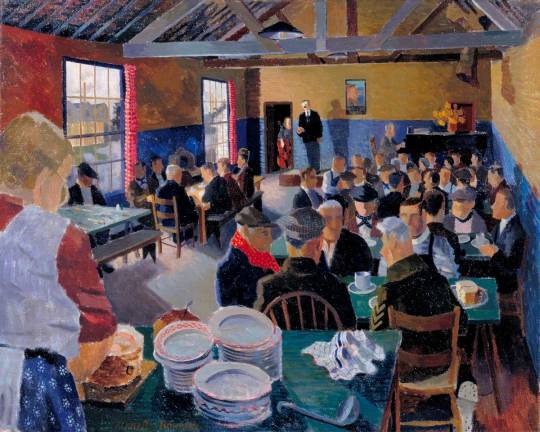
Kenneth Rowntree – The Council for the Encouragement of Music and the Arts Canteen Concert, Isle of Dogs, London, E14, 1940
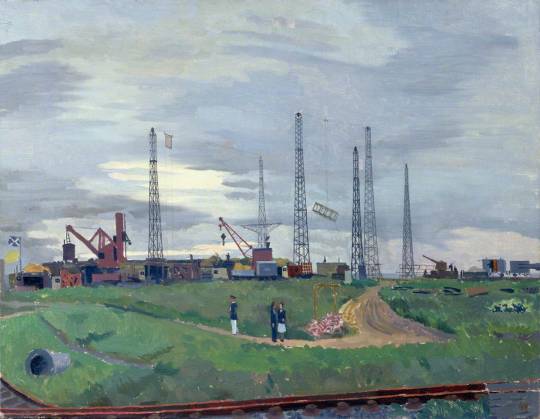
Kenneth Rowntree – The Experimental Establishment, Shoeburyness: Firing through Screens, 1945
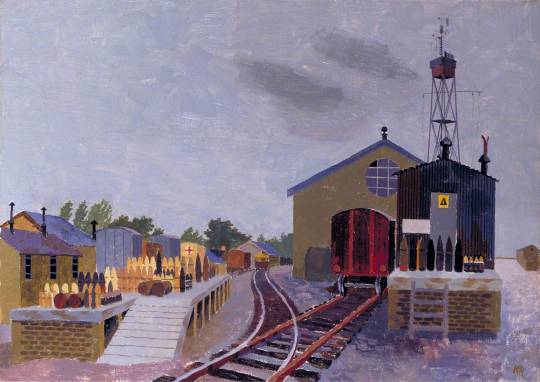
Kenneth Rowntree – Experimental Establishment, Shoeburyness, 1945
All the paintings below are part of the Recording Britain series.
In 1940, when the British landscape was under attack from the threat of German bombers, the Ministry of Labour, in association with the Pilgrim Trust commissioned many of Britain’s artists to go out and paint a record of the changing face of the country before it was too late. †
I think part of the romance of the pictures below is the lack of cars in pictures. No High Street in Britain will ever look beautiful again until cars are stored back in their garages and not parked on the street. Other than the Old Toll Bar House all the places are without figures, an empty world of architectural curiosity. I also feel that there is something beautiful about those multi-layered telegraph poles and wires in the same picture.
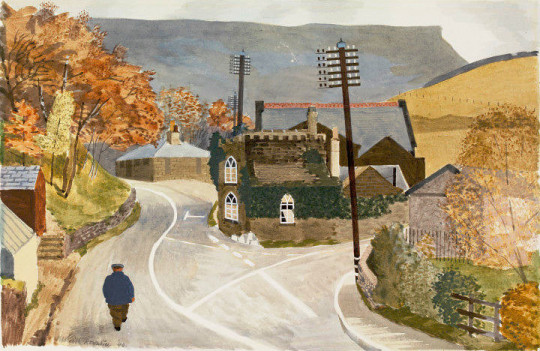
Kenneth Rowntree – Old Toll Bar House, Ashopton, 1940
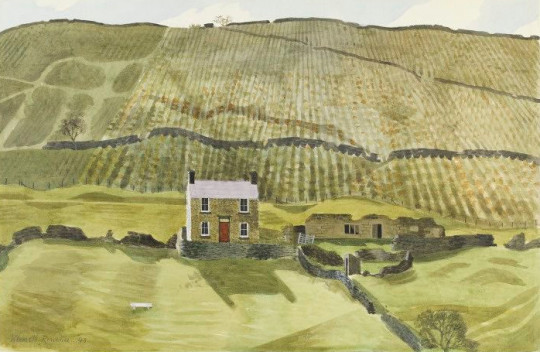
Kenneth Rowntree – Underbank Farm, Woodlands, Ashdale, Derbyshire, 1940
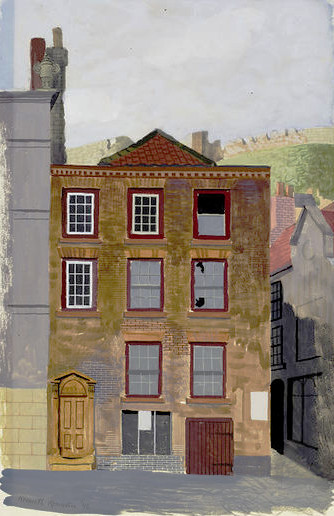
Kenneth Rowntree – Scarborough, 1940
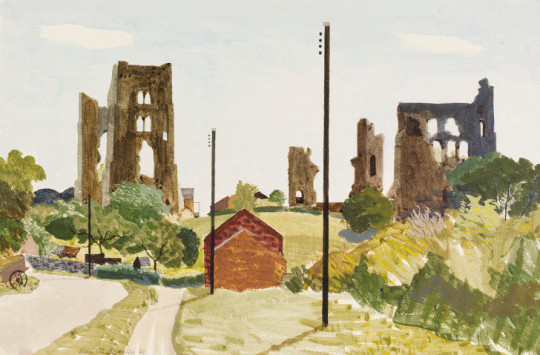
Kenneth Rowntree – The Castle, Sheriff Hutton, 1940
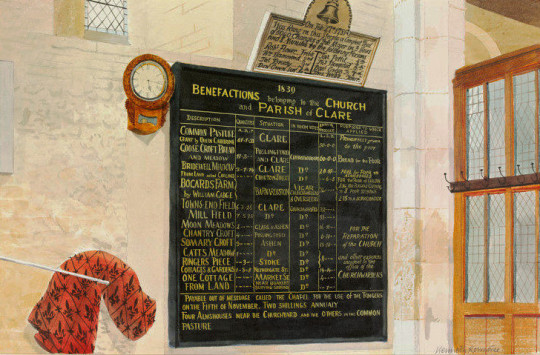
Kenneth Rowntree – The Bellringer’s Chamber, SS. Peter and Paul Church, Clare, 1940
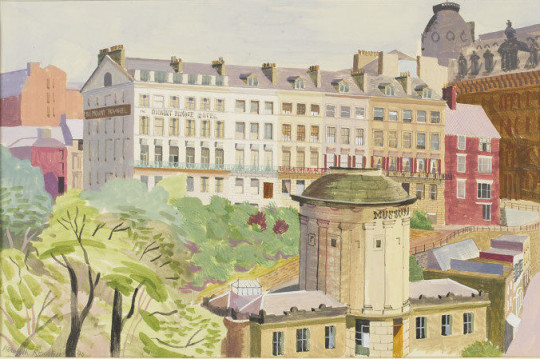
Kenneth Rowntree – Cliff Bridge Terrace and Museum, Scarborough, 1940
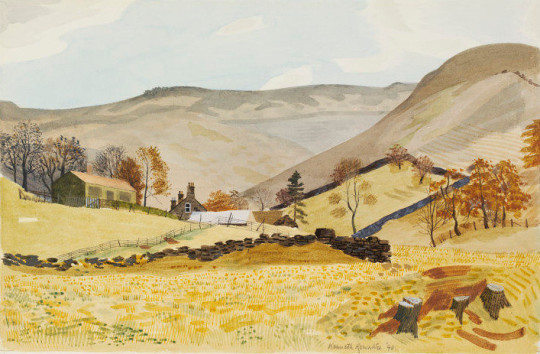
Kenneth Rowntree – Grainfoot Farm, Derwentdale, 1940
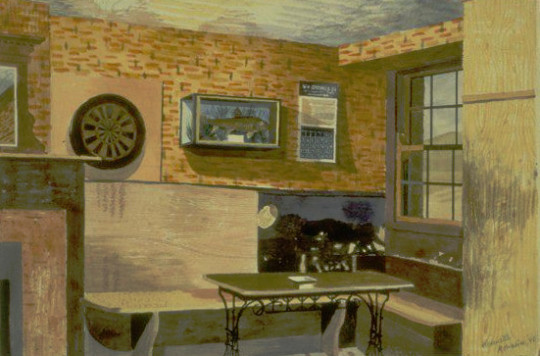
Kenneth Rowntree – The Smoke Room, Ashopton Inn, 1940
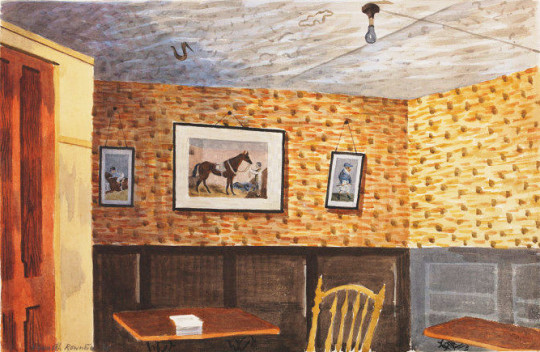
Kenneth Rowntree – The Smoke Room, Ashopton Inn, 1940
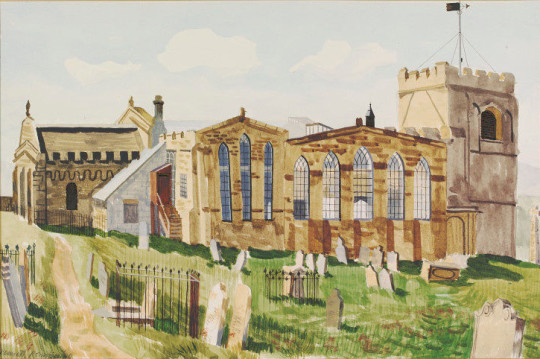
Kenneth Rowntree – St. Mary’s, Whitby – Exterior, 1940
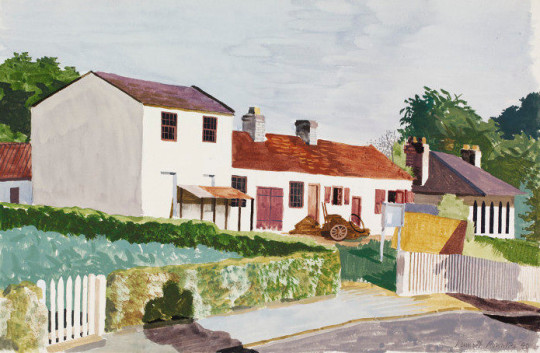
Kenneth Rowntree – The Smithy, Crathorne, 1940
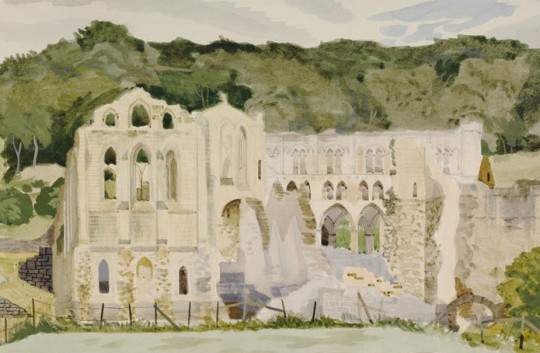
Kenneth Rowntree – Rievaulx Abbey, 1940
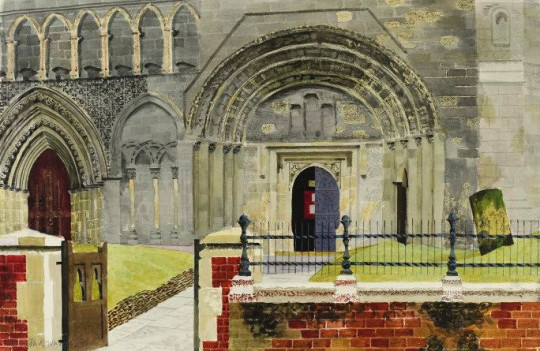
Kenneth Rowntree – West Front of the Priory Church, Dunstable, Bedfordshire, 1941
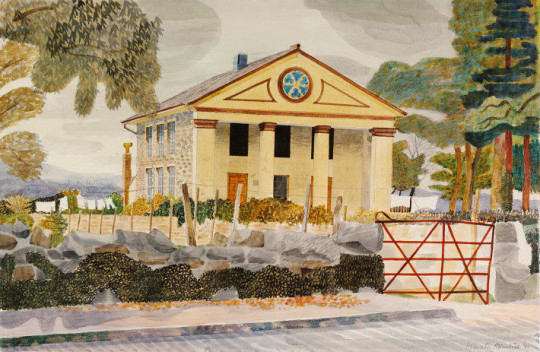
Kenneth Rowntree – Chapel Tremadoc, Caernarvonshire, 1941
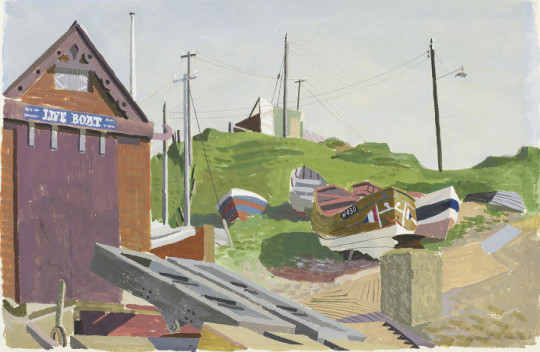
Kenneth Rowntree – North Landing, Flamborough, 1940
† David Mellor, Gill Saunders, Patrick Wright – Recording Britain , 1990
China clay is a material known as kaolin. It was first used in China more than ten thousand years agoto make porcelain. When the Chinese started to export this to Europe it was fashionable but expensive. Noticing a gap in the market, a Plymouth apothecary called William Cookworthy began to research the porcelain-making process and spent several years searching for a material that resembled the kaolin that had been used for so long in China. In 1745 he eventually found it, at Tregonning Hill, near Germoe, in Cornwall, where a rare type of decomposed granite, finer than most talcum powders, arises naturally.
The mining of this over the years scared the landscape with a white mountain of spill and a quarry pit. I have some memory that it was on one of these trips that John Nash painted with Edward Bawden and Carel Weight.
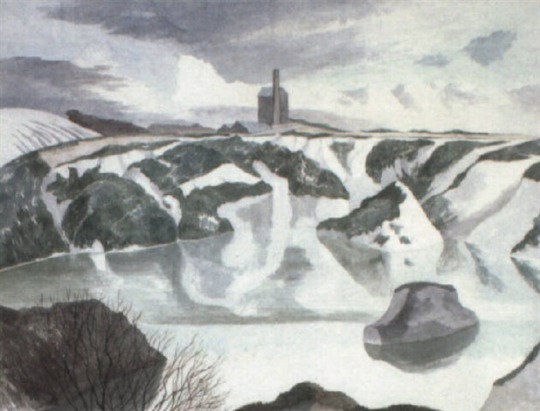
John Nash – Disused China clay pit near Hensborough
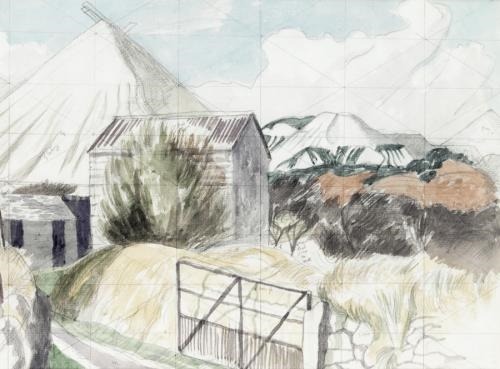
John Nash – China clay landscape
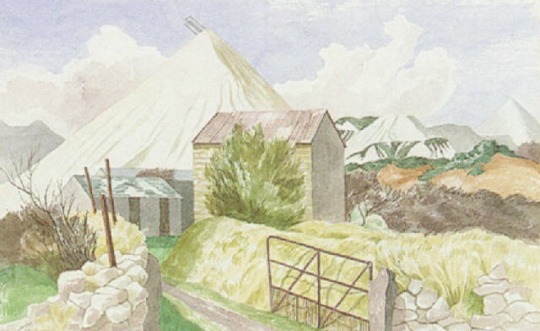
John Nash – A mine, Bugle, Cornwall
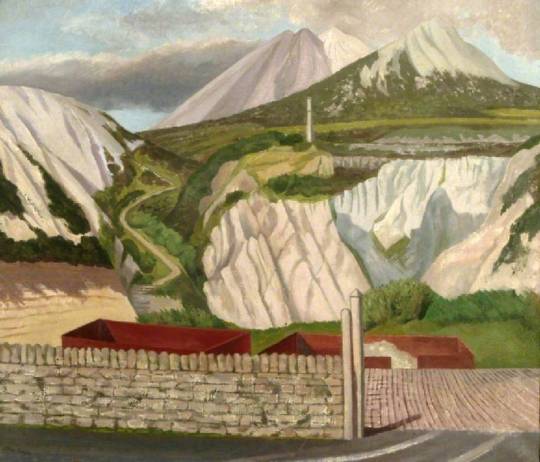
John Nash – Mountain Landscape with Distant Lake, 1939
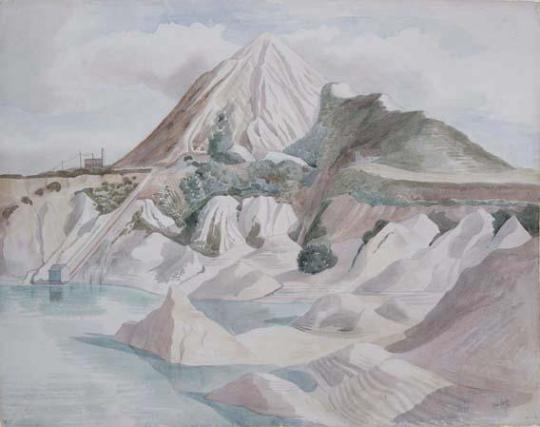
John Nash – China Clay Matterhorn 1952
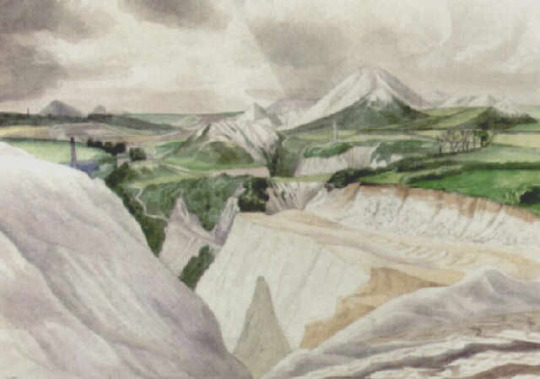
John Nash – Clay pits , 1954
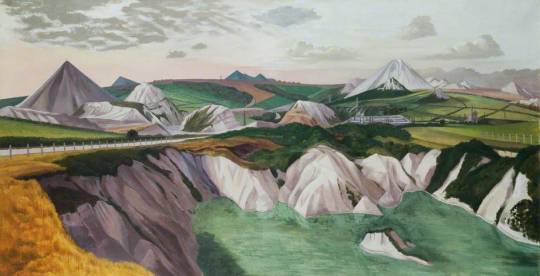
John Nash – Panorama of Pyramids, 1953
Below is a painting by Carel Weight, it’s the same view of the painting above by John Nash, is it chance or not? Nash used to make pencil drawings of a subject and then come back to it later in the year, maybe with some of his Cornish paintings he came back years later? Or just a fluke, who knows. It doesn’t help that the Weight picture isn’t dated.
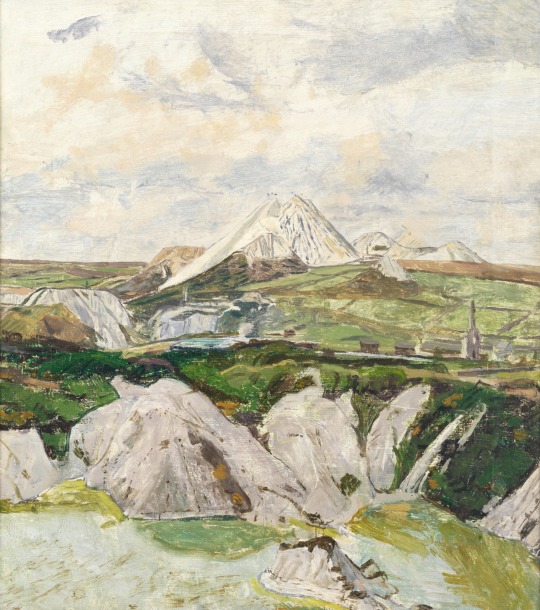
Carel Weight – Clay Pits, Cornwall
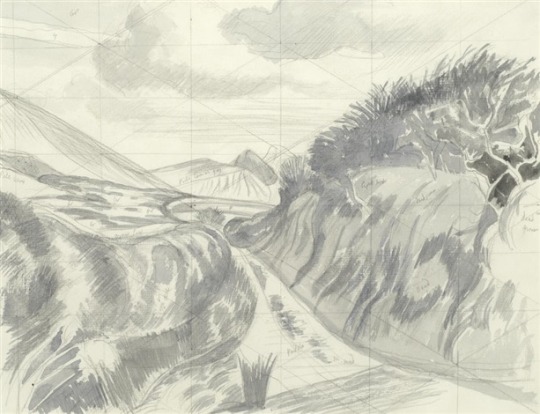
John Nash – China Clay Country, 1958
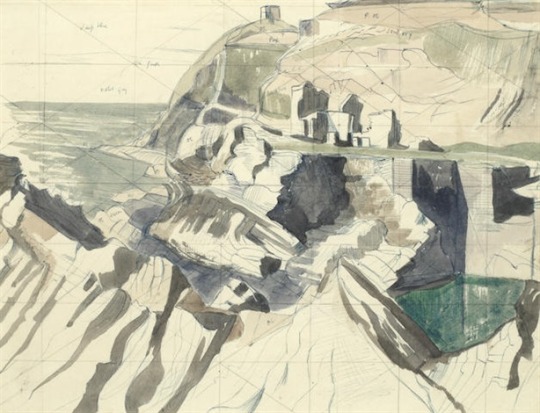
John Nash – China Clay Country , 1958
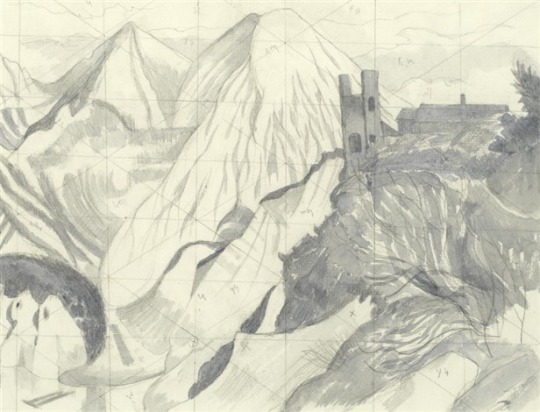
John Nash – China Clay Country, 1958
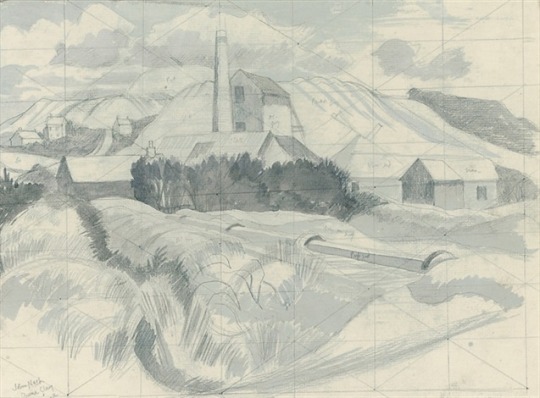
John Nash – China Clay, Cornwall
To see more of Edward Bawden’s paintings of the 1958 trip click here.